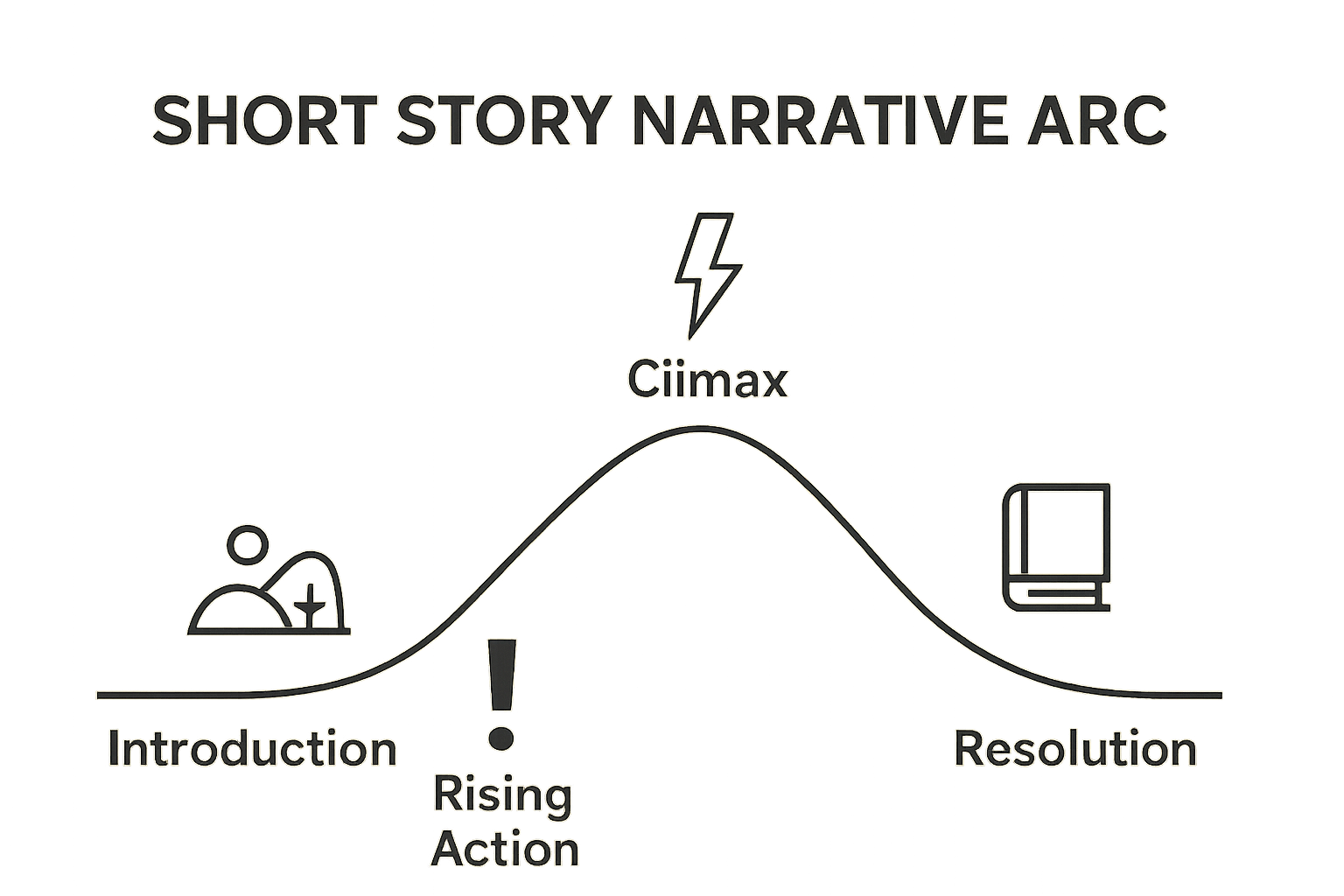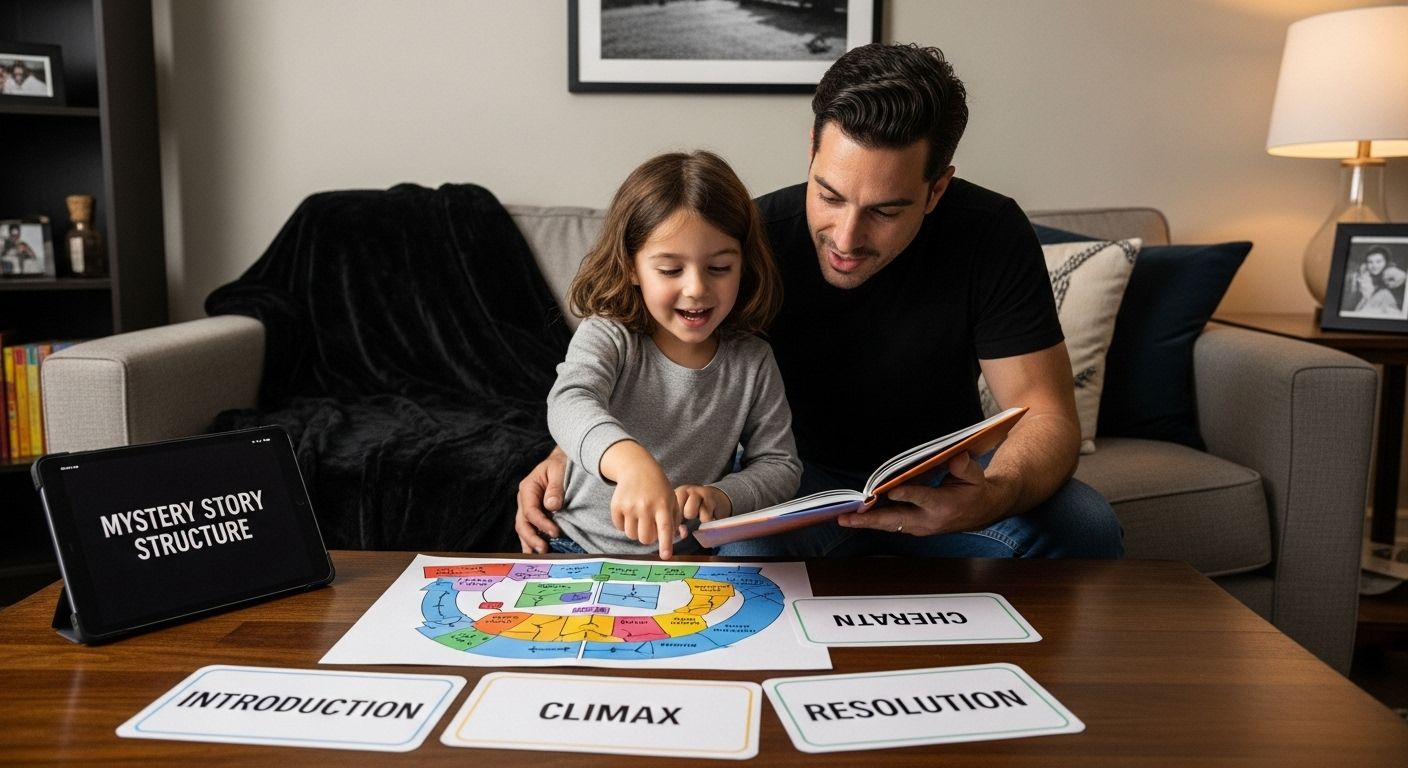Understanding Short Story Structure: A Deep Dive

Short story structure shapes more than just words on a page, acting as the backbone for any tale that actually sticks in your mind. You might think tales are all about wild imagination, but studies show that readers can recall up to 50 percent more details from stories with a clear structure. The real surprise? Effective structure is not about following strict rules but about unlocking emotional impact and deeper meaning in just a few pages.
Table of Contents
- What Is Short Story Structure And Why Is It Important?
- The Essential Components Of Short Story Structure
- How Short Story Structure Enhances Storytelling
- Common Short Story Structures In Mystery Fiction
- Real-World Examples Of Effective Short Story Structure
Quick Summary
| Takeaway | Explanation |
|---|---|
| Understanding core components is crucial | Knowing the elements of plot, character, and conflict shapes engaging narratives. |
| Master the narrative arc for emotional impact | Following a structured progression builds tension and emotional resonance in storytelling. |
| Emphasize conflict to drive your story | Central tension captivates readers and sustains their interest throughout the narrative. |
| Experiment with narrative structures | Innovative techniques can challenge conventions and enhance reader engagement, especially in mystery stories. |
| Analyze successful examples for inspiration | Studying effective stories reveals how masterful structure transforms simple narratives into rich literary experiences. |
What is Short Story Structure and Why is it Important?
Short story structure is the systematic framework that transforms a simple narrative into a compelling literary experience. Understanding short story structure allows writers to craft engaging stories that captivate readers and communicate complex ideas efficiently.
The Core Components of Story Structure
At its essence, short story structure involves several critical elements that work together to create a meaningful narrative. These components include:
- Plot: The sequence of events that drive the story forward
- Character Development: How the protagonist evolves through challenges
- Conflict: The central tension that creates narrative momentum
The Yale Teachers Institute emphasizes that plot represents the systematic chain of events which make up a short story. Each narrative event serves a specific purpose: introducing a problem, building tension, and ultimately resolving the central conflict.
Why Story Structure Matters
Effective short story structure goes beyond mere storytelling. It provides a strategic approach to communication that helps readers:
- Understand complex narratives quickly
- Anticipate narrative developments
- Connect emotionally with characters
Research suggests that recognizing text structures significantly enhances reading comprehension. When readers understand how a story is constructed, they can more deeply engage with the narrative, predict potential outcomes, and retain information more effectively.
Mastering short story structure is not just a technical skill but an art form. It transforms a collection of words into a powerful storytelling mechanism that can explore human experiences, challenge perspectives, and create lasting emotional impacts. Whether you are a writer crafting mysteries or a reader seeking engaging narratives, understanding story structure opens doors to richer, more meaningful literary experiences.
The Essential Components of Short Story Structure
A compelling short story is more than just a sequence of events. It is a carefully constructed narrative that requires specific structural elements working in harmony to create a memorable reading experience. Understanding these essential components helps writers craft stories that resonate deeply with readers.
Below is a table summarizing the essential components of short story structure and their roles in narrative development.
| Component | Description |
|---|---|
| Plot | Sequence of events that drive the story forward |
| Character Development | How the protagonist evolves through challenges |
| Setting | The backdrop where the story unfolds |
| Conflict | Central tension that propels the story forward |
| Narrative Arc | Progression from introduction to resolution |
The Foundational Building Blocks
Every short story comprises several key structural elements that transform raw narrative into an engaging piece of literature. These fundamental components include:
- Setting: The backdrop where the story unfolds
- Characters: The individuals who drive the narrative
- Conflict: The central tension that propels the story forward
According to Writer’s Digest, each of these elements must work synergistically to create a cohesive and impactful narrative.
Narrative Arc and Progression
The narrative arc represents the story’s emotional and dramatic progression. This arc typically follows a predictable yet dynamic pattern:

- Introduction: Establishing the initial situation
- Rising Action: Building tension and complexity
- Climax: The peak of dramatic intensity
- Resolution: Providing closure or insight
Each stage serves a specific purpose in guiding the reader through the story’s emotional landscape. The most effective short stories create a sense of inevitability, where each event feels both surprising and necessary.
Mastering these components requires understanding how they interconnect. A well-structured short story does not simply relay events but creates an immersive experience that captures the reader’s imagination, challenges their perspectives, and leaves a lasting impression. Whether crafting a mystery, exploring human relationships, or revealing profound truths, the essential components of short story structure provide the framework for powerful storytelling.
How Short Story Structure Enhances Storytelling
Short story structure serves as the architectural blueprint that transforms a simple narrative into a powerful emotional journey. By providing a strategic framework, structure enables writers to craft stories that resonate deeply with readers, creating memorable experiences that transcend mere words.
Creating Emotional Resonance
A well-structured story is like a precision instrument, designed to elicit specific emotional responses. Each narrative element strategically guides the reader through an intentional emotional landscape, building connections between the characters and the audience. Structure allows writers to:
- Control Pacing: Modulate narrative tension
- Create Anticipation: Build reader engagement
- Deliver Meaningful Revelations: Maximize narrative impact
The Grand Valley State University research demonstrates that strategic use of story structure directly enhances narrative effectiveness and reader satisfaction.
The Psychological Impact of Narrative Structure
Narrative structure operates on a profound psychological level. It mirrors how humans naturally process information and experience emotional journeys. By following a recognizable yet dynamic pattern, short stories can:
- Trigger familiar emotional pathways
- Provide cognitive satisfaction
- Create a sense of narrative completion
For readers interested in exploring more narrative techniques, discover our guide on mystery storytelling.
Ultimately, short story structure is not a rigid constraint but a flexible tool. It provides writers with a framework to explore complex human experiences, challenge perspectives, and create intimate connections with readers. The most compelling stories are those that understand and masterfully manipulate structural elements to deliver profound, lasting impressions.
Common Short Story Structures in Mystery Fiction
Mystery fiction demands a precise narrative architecture that captivates readers through strategic plot development and calculated revelations. The structural framework of mystery short stories is carefully designed to maintain suspense, engage readers, and deliver satisfying narrative experiences.
The Classic Mystery Story Arc
Most mystery short stories follow a distinctive structural pattern that systematically unfolds the narrative. This archetypal structure typically includes:
- Crime Introduction: Establishing the central mystery
- Detective Emergence: Introducing the problem solver
- Investigation Phase: Gathering clues and exploring leads
- Climactic Revelation: Solving the central mystery
- Resolution: Explaining the solution and its implications
According to Yale Teachers Institute, this four-part structure provides a comprehensive framework for developing compelling mystery narratives.
Variations in Mystery Story Structures
While the classic structure remains prevalent, contemporary mystery fiction explores innovative narrative approaches. Some alternative structures include:
- Reverse Chronology: Revealing the solution first, then exploring how it happened
- Multiple Perspective Narratives: Presenting the mystery through different characters
- Unreliable Narrator Techniques: Creating uncertainty about the storyteller
For readers eager to explore more intricate narrative techniques, dive into our guide on mystery fiction.
Mastering these structural variations requires understanding not just the mechanics of storytelling, but the psychological dynamics of reader engagement. The most compelling mystery short stories are those that skillfully manipulate narrative structure to create intellectual and emotional intrigue, transforming a simple sequence of events into a complex, immersive experience.
This table compares classic and contemporary mystery short story structures, highlighting their defining features and narrative techniques.
| Structure Type | Key Features | Narrative Technique Examples |
|---|---|---|
| Classic Mystery Structure | Follows established stages: crime, detective, clues, solution, resolution | Logical sequence, methodical progression |
| Reverse Chronology | Reveals outcome first, explores how events unfolded | Solution before investigation |
| Multiple Perspectives | Presents narrative through different characters | Shifting points of view |
| Unreliable Narrator | Creates uncertainty about storyteller or events | Ambiguous or deceptive narration |

Real-World Examples of Effective Short Story Structure
Effective short story structure transforms raw narrative potential into compelling literary experiences. By examining successful examples, writers and readers can understand how masterful storytelling emerges through strategic narrative design.
Structural Brilliance in Classic Mystery Stories
Some short stories demonstrate extraordinary structural precision that elevates them beyond ordinary narratives. These exemplary works showcase how carefully constructed narrative frameworks can create profound reader engagement:
- Edgar Allan Poe’s “The Tell-Tale Heart”: Employs a first-person unreliable narrator structure
- Agatha Christie’s Short Mysteries: Utilize tight, methodical plot progression
- O. Henry’s Twist Endings: Demonstrate unexpected structural revelations
According to National Academy of Sciences research, these stories consistently demonstrate predictable yet innovative narrative patterns that captivate readers.
Contemporary Narrative Innovations
Modern short story writers continue to push structural boundaries, developing innovative approaches that challenge traditional narrative conventions. These contemporary techniques include:
- Non-Linear Storytelling: Breaking chronological expectations
- Fragmented Narratives: Using disconnected scenes to build meaning
- Experimental Point-of-View Shifts: Challenging reader perspective
For readers interested in exploring more narrative techniques, discover our collection of compelling short mysteries.
Understanding these structural examples reveals that great storytelling is not about rigid rules, but about understanding how narrative elements interact. The most memorable short stories are those that use structure not as a constraint, but as a dynamic tool for exploring human complexity, emotional depth, and intellectual intrigue.
Transform Your Storytelling: Structure Meets Suspense
Do you ever struggle to turn your story ideas into unforgettable mysteries? If understanding short story structure feels overwhelming, you are not alone. The article spotlights key pain points like building emotional resonance, balancing plot with character, and mastering the classic mystery arc. These challenges can hold back even the most creative minds and keep compelling narratives from reaching their full potential.

Now is your chance to see how professional storytellers overcome these hurdles. At The Short Reads, you can explore expertly structured mystery and thriller short reads that bring the narrative techniques from this article to life. Ready to discover gripping stories that model the very best in short story structure? Visit our main site to start reading and give your storytelling inspiration a boost today. Dive into masterful mystery fiction now and watch your own plots take shape.
Frequently Asked Questions
What are the main components of short story structure?
The main components of short story structure include plot, character development, setting, conflict, and the narrative arc which encompasses introduction, rising action, climax, and resolution.
Why is understanding short story structure important for writers?
Understanding short story structure is crucial for writers as it helps them craft compelling narratives that engage readers, build tension, and effectively communicate complex ideas.
How does short story structure enhance emotional engagement?
Short story structure enhances emotional engagement by carefully controlling pacing, creating anticipation, and delivering meaningful revelations, which altogether guide the reader through an emotional journey.
What are common structural patterns found in mystery short stories?
Common structural patterns in mystery short stories include the introduction of the crime, the emergence of a detective, an investigation phase, a climactic revelation, and a resolution explaining the solution and its implications.
Recommended
Article generated by BabyLoveGrowth
Share